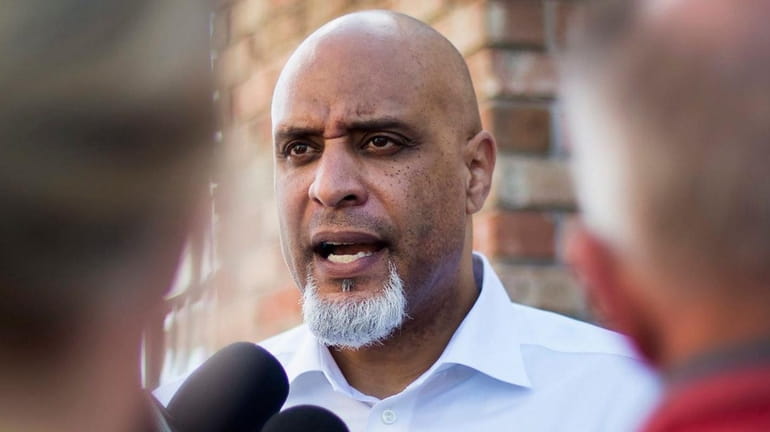MLB's latest proposal of 72-game season likely to be rejected by union

Tony Clark, head of the Major League Baseball Players Association speaks with the media after a union meeting with the Toronto Blue Jays during baseball spring training in Dunedin, Fla., on Friday, Feb. 24, 2017. Credit: AP/Nathan Denette
Friday’s 72-game proposal by Major League Baseball presented a few attractive elements to the Players Association, including a $310 million bump in salary over the previous offer earlier this week, according to multiple sources.
But it again omitted the main thing the players really want above all else, the one part they refuse to be flexible about, the driving force behind their entire negotiating stance. And that’s 100% prorated salaries — full pay for each game played.
This latest proposal, at best, offers 83% — contingent on the completion of the World Series, along with an additional $50 million playoff pool factored in. Anything short of that, and the players receive only 70%, multiple sources said.
A simple glance at those numbers suggests that the Players Association almost certainly will reject this proposal, as it did the previous two, on the salary issue alone. Union chief Tony Clark considers the rate of pay settled by the March 26 agreement, and the Players Association has not budged a single percentage point since these negotiations began a month ago.
There is no reason to expect the union to do so now, even though Friday’s pitch could deliver $1.5 billion in salary (with the finished playoffs). And with a Sunday night deadline attached to this proposal, the sport is grinding closer to a commissioner-mandated season of roughly 48 games, at full pro rata salary for the players, which coincidentally would guarantee roughly the same base pay as Friday’s 70% pitch.
It’s hard to see this going any other way, especially after another nasty letter exchange Friday, this time from deputy commissioner Dan Halem to union chief negotiator Bruce Meyer. At issue is what MLB sees as stonewalling by the union on salaries.
“We recognize this has essentially been a negotiation with ourselves,” Halem writes to Meyer in the letter obtained by The Athletic. “You suggest in your letter that the Association’s 89-game proposal at full daily salaries ‘is made in the interests of settlement.’ However, the parties are not engaged in settlement discussions, and it is unclear what exactly you are trying to ‘settle.’ Nevertheless, it is clear to me that the parties’ differing interpretations of the March agreement has been a stumbling block to negotiating a resolution that is in the interests of both sides.”
While a source said Friday’s proposal is not necessarily a last-best offer from MLB, the season is rapidly shrinking. That adds up to less money for the players, who have grown increasingly frustrated by the process.
“The owners’ whole strategy from the beginnings has been this,” the Reds’ Trevor Bauer tweeted Friday, “play as few regular-season games as possible to limit player cost as much as possible. Play as many postseason games as possible to drive revenue as high as possible. They’re more than happy to play only 50 games . . . ”
After Sunday, a source said, MLB will start operating within a 68-game window for the regular season. Commissioner Rob Manfred repeatedly has said he does not want to push the playoffs into November because of concern about a second wave of coronavirus.
As a result, Friday’s proposal mapped out a 72-game season (preceded by 21 days of spring training) that runs from July 14 to Sept. 27, which would allow for expanded playoffs, with as many as eight teams from each league. Both sides have included this larger postseason format in their recent proposals as it would be worth more than $800 million in revenue.
Beyond that, MLB did include some other appealing features, such as increasing rosters to 30 players for the first two weeks and 28 for the next two weeks, which would mean additional big-league jobs and service time. Also, this proposal allows for players at high health risk to opt out and still receive full salary and service time; others can do so without penalty but would not be compensated by either means.
As in earlier proposals, MLB offered to drop the draft pick compensation attached to free agents for this winter and the next. But with teams expecting massive losses because of the lack of gate-related revenue this year, spending is likely to dry up for the foreseeable future, so it’s unclear how much of an actual benefit that would be to players.
While Friday’s proposal did come up some in salary for the players, the number of games is dwindling. MLB started these talks at 82 games in mid-May, with sliding-scale pay reductions, and then dropped to 76 games by Monday’s offer, at 50% guaranteed salaries (with another 25% tacked on for the completion of the World Series). Compare that with the union’s proposals of 114 and 89, both at full prorated salaries.
After all this, the sides remain far apart and seem headed for whatever fate Manfred chooses.
A source reaffirmed Friday that MLB is inclined to go to 100% only at roughly 48 games. That would facilitate the return of baseball — but with the sport ablaze in bad feelings all around.
MLB’s Proposal
Games: 72
Pro rata salaries: 70% for regular season, 83% if postseason is completed.
Guaranteed salary total: $1.5 billion
Roster size: 30 for two weeks, then 28 for two weeks, then 26 for remainder of season.
Postseason teams: Up to 16
Start date for season: Approx. July 14
End date: Sept. 27

